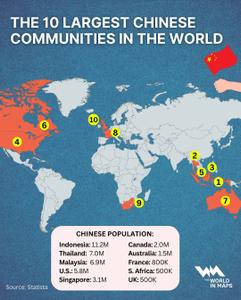population
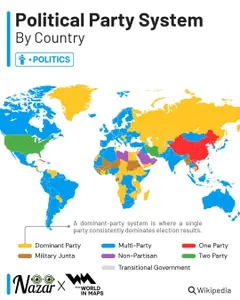
Politics / 6 hours ago
Global party systems and what they mean for today’s politics
While many countries embrace multiparty competition, others remain under dominant or single-party systems that shape governance and democracy in distinct ways. While many countries embrace multiparty competition, others remain under dominant or single-party systems that shape governance and democracy in distinct ways. According to Britannica, party systems are broadly categorised as two-party, multiparty, or single-party, depending not only on the number of parties but also on how effectively they compete for control and share power.

Environment / 3 weeks ago
Muslims in Europe are having more children than non-Muslims
Across Europe, birth rates tell a changing story. According to new findings from the Pew Research Center, Muslim families are having more children on average than non-Muslims, a pattern that is reshaping the region’s population dynamics. From 2015 to 2020, Muslim women in countries like Finland recorded an average of 3.1 children per woman, compared to 1.7 among non-Muslims.

World / 3 weeks ago
5 of the world’s 10 largest countries now below replacement-level fertility
Across much of the world, people are having fewer children than ever before. A new visual from World Visualised, using World Bank data, shows a striking pattern: between 2000 and 2023, fertility rates in the ten largest countries have fallen sharply, and in five of them, they’ve dropped below the replacement level of 2.1 births per woman. According to the data, this includes China, Russia, the United States, Brazil, and Indonesia, nations that together make up nearly half of the world’s population. Meanwhile, countries like Nigeria, Ethiopia, Pakistan, Bangladesh, and India have also seen steady declines, though their rates remain above replacement for now.
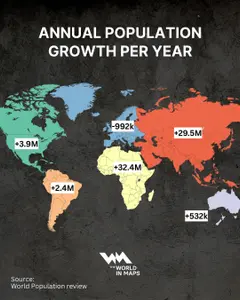
World / 3 weeks ago
Africa leads the world in population growth as Europe shrinks
The world’s population is still growing, but not evenly. According to the World Population Review, Africa is adding about 32.4 million people every year, making it the fastest-growing continent on Earth. Asia follows closely, increasing by around 29.5 million people per year. In contrast, Europe’s population is shrinking, losing nearly one million people annually.

Maps / 6 weeks ago
Over 40 million residents in Europe were born outside the EU
According to data available on January 1, 2024, 44.7 million people living in the EU were born outside the Union (about 9.9% of the population). A further 17.9 million were born in another EU country. Together, these groups explain much of the bloc’s population growth and a growing share of its workforce. By absolute size, Germany hosts the EU’s largest foreign-born population (15.8 million), followed by France (10.1 million), the UK (9.6 million) and Italy (6 million).

World / 6 weeks ago
Why some nations have more men and others more women
A world map produced by The World in Maps tellingly shades nations by whether they have more men or more women — red where women are in the majority, blue where men outnumber women. Globally, as of 2025, there are about 101.07 males for every 100 females in the world population. That slight male majority is driven largely by higher birth ratios favouring boys, though over time that tilt tends to fade as women live longer on average.
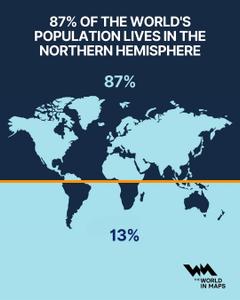
World / 7 weeks ago
Why nearly 9 in 10 people live in the northern hemisphere
Look at any global map of population distribution and one striking fact becomes immediately clear: nearly 87% of the world’s people live north of the Equator, while only about 13% live in the Southern Hemisphere. This lopsided distribution arises largely because the Northern Hemisphere contains more landmass, including Asia, Europe, most of North America, and a large portion of Africa, which in turn supports dense urbanisation, infrastructure, and economic activity.
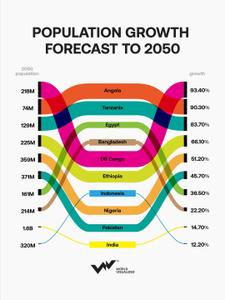
World / 9 weeks ago
Africa set to power global population growth as world nears 10 billion
The world’s demographic map is changing rapidly, and the shift is most visible in Africa. Several African countries are set to experience extraordinary population growth by 2050, while other regions of the world will expand more slowly or even begin to decline. The United Nations’ World Population Prospects 2024 projects that the global population will climb from around 8.16 billion in 2024 to 9.66 billion by 2050.

Maps / 11 weeks ago


